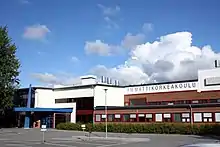Kokkola
Kokkola (Finnish: [ˈkokːolɑ]; Swedish: Karleby, Finland Swedish: [ˈkɑrleˌbyː]) is a town and municipality of Finland. The town is located in the Central Ostrobothnia region. The town has a population of 48,204 (26 October 2023)[2] and covers an area of 2,730.80 square kilometres (1,054.37 sq mi) of which 1,286.61 km2 (496.76 sq mi) is water.[1] The population density is 33.38 inhabitants per square kilometre (86.5/sq mi). Neighbour municipalities are Halsua, Kalajoki, Kannus, Kaustinen, Kronoby, Lestijärvi, Larsmo and Toholampi.
Kokkola
| |
|---|---|
Town | |
| Kokkolan kaupunki Karleby stad | |
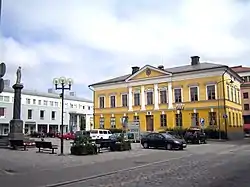 Old Kokkola town hall | |
 Flag  Coat of arms | |
 Location of Kokkola in Finland | |
| Coordinates: 63°50.2′N 023°08′E | |
| Country | |
| Region | Central Ostrobothnia |
| Sub-region | Kokkola sub-region |
| Charter | 1620 |
| Government | |
| • Town manager | Stina Mattila |
| Area (2018-01-01)[1] | |
| • Total | 2,730.80 km2 (1,054.37 sq mi) |
| • Land | 1,444.20 km2 (557.61 sq mi) |
| • Water | 1,286.61 km2 (496.76 sq mi) |
| • Rank | 46th largest in Finland |
| Population (2023-10-26)[2] | |
| • Total | 48,204 |
| • Rank | 22nd largest in Finland |
| • Density | 33.38/km2 (86.5/sq mi) |
| Population by native language | |
| • Finnish | 83.6% (official) |
| • Swedish | 12.2% |
| • Others | 4.2% |
| Population by age | |
| • 0 to 14 | 18.6% |
| • 15 to 64 | 58.8% |
| • 65 or older | 22.6% |
| Time zone | UTC+02:00 (EET) |
| • Summer (DST) | UTC+03:00 (EEST) |
| Website | www.kokkola.fi |
The municipality is bilingual with 83.6% being Finnish and 12.2% Swedish speakers.
Kokkola celebrated its 400th anniversary in 2020.
Etymology
Name
In the oldest Swedish sources Kokkola is mentioned as Karlabi. The town was known in Swedish by the name Gamlakarleby until 1 January 1977 when the surrounding land municipality of Kaarlela (Swedish: Karleby) was consolidated with Kokkola, and the town took over the Swedish name of Karleby. The word gamla means "old", karl (anglicanized Charles), is a Germanic males name, a name of many kings, meaning simply "man" and by means "village", so the town name is ambiguous meaning both "old village of Charles" or "old man village". The Latin name was Carolina Vetus. Gustav II Adolf, the founder of the city, possibly named the town in honor of his father King Karl IX of Sweden. The Finnish name is possibly derived from Kokkolahti, a narrow bay located at the place of the town. According to a tale the sea eagles (in Finnish merikotka or kokko) used to live there.[5] Another theory claims that the name comes from ancient signal fires (kokko), which were used to warn people about approaphing enemy troops.
Heraldry
The coat of arms of Kokkola is based on the city seal issued in 1620 in connection with the founding of the city. The pattern is a symbol of tar burning and tar trade, which have played a significant part in the history of the city since its founding until the 19th century. The coat of arms was designed by Olof Eriksson and Into I. Suominen, and it was confirmed for use on December 17, 1956.[6][7][8]
History
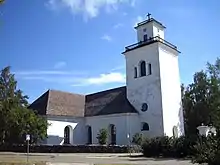
The town of Kokkola was chartered in 1620 by King Gustav II Adolf of Sweden when Finland was a part of the Swedish Empire and is one among the oldest towns in Finland. The king also decided that a tar barrel, with three burning flames coming from both the ends and the plug, should be used as the town seal, because of the tar trade at that time, for which Kokkola was founded as a shipping port. Anders Chydenius (1729-1803) who was one of the leading politicians of Sweden-Finland, was a keen supporter of economic freedom and fought in the Swedish Parliament for free foreign trade and further social reforms. In 1765 the Swedish Parliament granted the city of Kokkola the staple rights. Kokkola also became an important shipbuilding centre in Finland. As a result of tar trade and shipbuilding industry, Kokkola was for a time one of the richest towns in Finland.
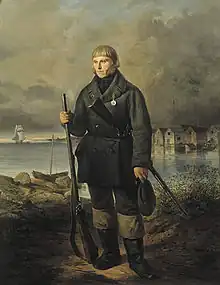
An interesting historical affair, known as the Skirmish of Halkokari, occurred at the town on 7 June 1854 during the Åland War, part of the Crimean War. Royal Marines from HMS Vulture and HMS Odin tried to come ashore to deal with public property in the town "in accordance with the usages of war". The marines were repelled by local defenders armed with hunting rifles supported by troops, artillery and possibly Russian advisors and military. One of the 9 smaller British craft (a gunboat) fell into the hands of the defenders. As such, this boat was the only Royal Navy vessel still in foreign possession in 1914. The boat is still today a museum-object and can be seen in Kokkola's English Park. The town council has refused to return the boat despite several requests by the United Kingdom, most recently by John Stuttard, the Lord Mayor of London. The British Treasury annually pays a small sum to the local church congregation for the maintenance of the graves of nine Royal Marines killed in action during the skirmish .[9]
Interesting contemporaneous accounts of the disastrous action can be found in the British Newspaper Archive, citing Gamla Carleby.
The city had a Swedish-speaking majority until 1933.
In 1977, the surrounding municipality of Kaarlela (Swedish: Karleby) was consolidated into Kokkola (Swedish until then: Gamlakarleby). In 2009, the municipalities of Lohtaja, Kälviä and Ullava were consolidated with Kokkola.
Geography
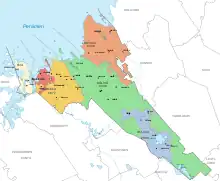
Kokkola is the capital of the Central Ostrobothnia region, it is located on the coast of Gulf of Bothnia, the northernmost part of the Baltic Sea. The next larger cities are Vaasa is 121 kilometres (75 miles) southwest, and Oulu is 198 kilometres (123 miles) northeast. The distance to the capital Helsinki is 483 kilometres (300 miles) to the south. Neighbouring cities and municipals are Kalajoki in the northern east, Kannus and Toholampi in the east, Halsua and Kaustinen in the southern east, Kronoby in the south and Larsmo in the southern west.
The landscape of the region around Kokkola is flat, typical for the area of Ostrobothnia, with numerous river courses flowing through the land. The biggest river in the area is Perhonjoki, which flows into Gulf of Bothnia, north of Kokkola.
The annual post-glacial rebound at Kokkola is 8.8 mm. Thus large areas of present-day Kokkola were under water when the town was founded.
Climate
| Climate data for Kokkola-Pietarsaari airport, normals 1991-2020, extremes 1961 - present | |||||||||||||
|---|---|---|---|---|---|---|---|---|---|---|---|---|---|
| Month | Jan | Feb | Mar | Apr | May | Jun | Jul | Aug | Sep | Oct | Nov | Dec | Year |
| Record high °C (°F) | 9.1 (48.4) |
10.4 (50.7) |
13.9 (57.0) |
21.4 (70.5) |
29.6 (85.3) |
32.6 (90.7) |
34.3 (93.7) |
31.3 (88.3) |
27.6 (81.7) |
20.9 (69.6) |
12.3 (54.1) |
8.4 (47.1) |
34.3 (93.7) |
| Average high °C (°F) | −3.2 (26.2) |
−3.2 (26.2) |
0.9 (33.6) |
7.4 (45.3) |
14.1 (57.4) |
18.5 (65.3) |
21.7 (71.1) |
19.6 (67.3) |
14.2 (57.6) |
6.8 (44.2) |
1.8 (35.2) |
−1.0 (30.2) |
8.1 (46.6) |
| Daily mean °C (°F) | −6.2 (20.8) |
−6.9 (19.6) |
−3.3 (26.1) |
2.4 (36.3) |
8.3 (46.9) |
13.5 (56.3) |
16.4 (61.5) |
14.6 (58.3) |
9.6 (49.3) |
3.8 (38.8) |
−0.5 (31.1) |
−3.9 (25.0) |
4.0 (39.2) |
| Average low °C (°F) | −10.1 (13.8) |
−10.6 (12.9) |
−7.4 (18.7) |
−2.2 (28.0) |
2.4 (36.3) |
7.6 (45.7) |
11.1 (52.0) |
9.5 (49.1) |
5.2 (41.4) |
0.5 (32.9) |
−3.1 (26.4) |
−6.7 (19.9) |
−0.3 (31.4) |
| Record low °C (°F) | −40.5 (−40.9) |
−41.5 (−42.7) |
−33.4 (−28.1) |
−22.2 (−8.0) |
−10.1 (13.8) |
−3.6 (25.5) |
−0.5 (31.1) |
−3.2 (26.2) |
−8.6 (16.5) |
−22.2 (−8.0) |
−32.2 (−26.0) |
−37.9 (−36.2) |
−41.5 (−42.7) |
| Source: FMI climatological normals for Finland 1991–2020 | |||||||||||||
| Climate data for Kokkola Tankar (1991–2020 normals, extremes 1996- present) | |||||||||||||
|---|---|---|---|---|---|---|---|---|---|---|---|---|---|
| Month | Jan | Feb | Mar | Apr | May | Jun | Jul | Aug | Sep | Oct | Nov | Dec | Year |
| Record high °C (°F) | 6.0 (42.8) |
6.3 (43.3) |
11.1 (52.0) |
18.5 (65.3) |
23.3 (73.9) |
28.6 (83.5) |
30.2 (86.4) |
30.3 (86.5) |
22.9 (73.2) |
18.4 (65.1) |
11.0 (51.8) |
7.7 (45.9) |
30.3 (86.5) |
| Average high °C (°F) | −2.1 (28.2) |
−3.1 (26.4) |
0.1 (32.2) |
4.3 (39.7) |
9.8 (49.6) |
14.9 (58.8) |
18.7 (65.7) |
17.9 (64.2) |
13.3 (55.9) |
7.3 (45.1) |
2.8 (37.0) |
0.1 (32.2) |
7.0 (44.6) |
| Daily mean °C (°F) | −4.5 (23.9) |
−5.8 (21.6) |
−3.1 (26.4) |
1.1 (34.0) |
6.1 (43.0) |
11.5 (52.7) |
15.7 (60.3) |
15.3 (59.5) |
11.1 (52.0) |
5.7 (42.3) |
1.2 (34.2) |
−1.8 (28.8) |
4.4 (39.9) |
| Average low °C (°F) | −7.0 (19.4) |
−8.5 (16.7) |
−5.5 (22.1) |
−1.2 (29.8) |
3.9 (39.0) |
9.5 (49.1) |
13.6 (56.5) |
13.2 (55.8) |
9.1 (48.4) |
3.9 (39.0) |
−0.6 (30.9) |
−3.9 (25.0) |
2.2 (36.0) |
| Record low °C (°F) | −30.2 (−22.4) |
−28.3 (−18.9) |
−23.7 (−10.7) |
−16.2 (2.8) |
−4.8 (23.4) |
1.8 (35.2) |
7.3 (45.1) |
6.5 (43.7) |
2.0 (35.6) |
−5.8 (21.6) |
−17.7 (0.1) |
−25.4 (−13.7) |
−30.2 (−22.4) |
| Average relative humidity (%) | 88 | 88 | 85 | 83 | 80 | 80 | 82 | 82 | 83 | 85 | 89 | 89 | 85 |
| Source 1: FMI normals 1991-2020[10] | |||||||||||||
| Source 2: Record highs and lows[11] | |||||||||||||
Demographics
Population
The city of Kokkola has 48,204 inhabitants, making it the 22nd most populous municipality in Finland. The Kokkola region has a population of 53,454. In Kokkola, 4.4% of the population has a foreign background, which is below the national average.[12]
| Year | Population |
|---|---|
| 1990 | 43,267 |
| 1995 | 44,441 |
| 2000 | 44,182 |
| 2005 | 44,627 |
| 2010 | 46,260 |
| 2015 | 47,570 |
| 2020 | 47,772 |
Languages
Population by mother tongue (2022)[12]
The city of Kokkola is officially bilingual, with both Finnish and Swedish as official languages. The majority of the population - 40,113 people or 83.6% - speak Finnish as their first language. In Kokkola, 5,876 people, or 12.2% of the population, speak Swedish.[12] 4.2% of the population of Kokkola have a mother tongue other than Finnish or Swedish.[12] As English and Swedish - or Finnish for Swedish speakers - are compulsory school subjects, functional bilingualism or trilingualism acquired through language studies is not uncommon.
Kokkola marks the northernmost settlement area of the Swedish-speakers (Fenno-Swedish) on the western coast of Finland. The Swedish-speaking inhabitants of Kokkola are spread unevenly around Kokkola: Whereas the centre of the city is bilingual, the majority of the villages around Kokkola mostly speak Swedish. The districts which were consolidated in 2009 are, however, pure Finnish-speaking areas.
At least 30 different languages are spoken in Kokkola. The most common foreign languages are Russian (0.6%), Arabic (0.4%), English (0.4%) and Chinese (0.3%).[12]
Immigration
| Population by country of birth (2022)[12] | ||
| Nationality | Population | % |
|---|---|---|
| 45,626 | 95.0 | |
| 435 | 0.9 | |
| 197 | 0.4 | |
| 135 | 0.3 | |
| 115 | 0.2 | |
| 91 | 0.2 | |
| 89 | 0.2 | |
| 71 | 0.1 | |
| 65 | 0.1 | |
| 64 | 0.1 | |
| 53 | 0.1 | |
| Other | 1,065 | 2.2 |
In 2022, there were 2,091 persons with a migrant background living in Kokkola, or 4.4% of the population.[note 1] The number of residents who were born abroad was 2,380, or 5.0% of the population. The number of persons with foreign citizenship living in Kokkola was 1,380.[14] Most foreign-born citizens came from Sweden, the former Soviet Union, Thailand and China.[12]
The relative share of immigrants in Kokkola's population is below the national average. However, the city's new residents are increasingly of foreign origin. This will increase the proportion of foreign residents in the coming years.
Religion
In 2022, the Evangelical Lutheran Church was the largest religious group with 73.9% of the population of Kokkola. Other religious groups accounted for 2.1% of the population. 24.0% of the population had no religious affiliation.[12]
Economy

Kokkola is the capital and biggest city in the region of Central Ostrobothnia. The chemical industry is a major employer. An industrial area and the city's port are located in Ykspihlaja. OMG has a cobalt plant. The Freeport/Umicore refinery is the only large cobalt refinery outside China.[15] Boliden has a zinc plant. Kemira, a chemical conglomerate, built an industrial park that is now divided among several corporations. In addition, industries represented in the town include metalworking, casting, textiles, plastics, food and carpentry. Largest employers are as follows (2011):
- The city of Kokkola approx. 2.350
- Central Ostrobothnian Joint Municipal Authority for Social and Health Services (Soite) 2.500
- Boliden Kokkola Oy (zinc) 500
- Umicore (was Freeport Cobalt Oy until 2019)[15] (cobalt) 420
- KPO group (retail) 400
- Halpa-Halli (retail) 300
- CABB Oy (fine chemicals) 200
The Port of Kokkola is located in Ykspihlaja, approximately 5 km (3 mi) from the city center, and it is one of the busiest ports in Finland. Oil, ore and limestone are imported, refined products and timber are exported, and iron ore is transited.
The Chydenia Shopping Center, completed in 2006, is located in the center of Kokkola;[16] about 2 million people visit at the shopping center every year.[17]
Transport
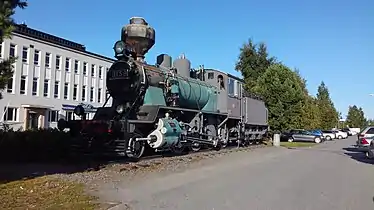
Kokkola is located on the coast of Gulf of Bothnia, and the coastal European route E8 (Finnish highway 8) goes through, connecting Oulu and Turku via Vaasa. Finnish highway 28 begins from Kokkola and runs to Kajaani. Finnish highway 13 begins from Kokkola and runs through Finland into the Nuijamaa border to Russia crossing via Jyväskylä and Mikkeli. The scenic '7 Bridges Archipelago Road' (road 749) runs along the coast between Kokkola and Jakobstad (Finnish: Pietarsaari). Kokkola-Pietarsaari Airport is situated 22 kilometres (14 mi) from Kokkola in Kronoby. The Kokkola railway station is a stop along the Seinäjoki–Oulu railway, with service between Helsinki and Kemijärvi via Tampere and Seinäjoki, where the fast Pendolino bullet train operates. There is no passenger ferry traffic from Kokkola.
Politics
Results of the 2021 Finnish municipal elections in Kokkola:
| Party | Seats |
|---|---|
| Centre Party | 10 |
| Social Democratic Party | 8 |
| True Finns | 7 |
| National Coalition Party | 6 |
| Swedish People's Party | 4 |
| Christian Democrats | 4 |
| Left Alliance | 2 |
| Green League | 2 |
Culture and sights

The city is the home of the world-renowned Ostrobothnian Chamber Orchestra, which was founded by the conductor Juha Kangas in 1972.
Buildings
The area of old wooden houses in the downtown area of Neristan has been the setting for the life and livelihood of its inhabitants for hundreds of years. Today these houses are offering restaurants, cafés, little shops and even accommodation for tourists. With its old charm it invites visitors to discover Neristan step by step.
Tankar island, a lighthouse island, is in the outer archipelago, about 18 km (11 mi) northwest from Kokkola. The island houses a lighthouse which is still in use today, a museum of seal-hunting, a bird-watching tower, a lot of nature trails and even accommodations for tourists. It is easy to reach the island by ferry m/s Jenny from Kokkola.
The stone Evangelical-Lutheran Church of Kaarlela has been a landmark since 1550 and is a popular venue for weddings and concerts. Next to the church, there is a local history museum at Kirkonmäki with an Ostrobothnian farmhouse, as well as an old smithy, a tannery, a wool-carding workshop, a threshing barn, a smoke sauna, a granary barn and a loft.
K.H.Renlund Museum is devoted to Karl Herman Renlund, who donated his large art collection to the town of Kokkola. The museum houses some temporary exhibitions and the museum shop. Next to the museum is the Pedagogio, a school-house, which is Finland's oldest urban secular wooden building (built in 1696). In this quarter, there is also the Lassander House which offers a glimpse into a merchant home in the 18th century.
Sport
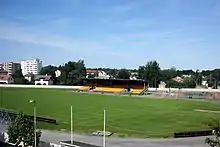
During the winter time, Kokkola offers 20 skiing tracks with a total length of 150 km (93 mi). Kokkola is the home of the ice hockeyclub Hermes, which plays in the second highest Finnish league (mestis). Moreover, there are the soccer clubs Kokkolan Palloveikot (KPV), which plays in the second highest Finnish league (Ykkönen) and Gamlakarleby Bollklubb (GBK), which plays in the third highest Finnish league (Kakkonen). Kokkola's volleyball team Kokkolan Tiikerit is active in the highest Finnish volleyball league and current Finnish champions for men (Lentopallon Mestaruusliiga). Sailing clubs include Gamlakarleby Segelförening, Kokkolan Purjehtijat and Kokkolan venekerho. There is also an american football team Karleby Goats, which plays in the third highest Finnish american football league (Amerikkalaisen jalkapallon II-divisioona).
Education
Kokkola has a lot of preschools, some of them offer children a bilingual education from an early age (mostly Finnish-English or Finnish-Swedish). There are 25 Finnish-speaking and 8 Swedish-speaking schools. Moreover, there are three secondary schools for Finnish-speaking pupils and one for Swedish-speaking. Some schools offer a dual vocational education and training. The Chydenius-Institution of Kokkola, a university consortium, carries out teaching and research under the auspices of the universities of Jyväskylä, Oulu and Vaasa. It is specialized in adult education. For Finnish and foreign students it arranges open university studies, further education for professionals in the fields of education, social services and health services and management. Centria University of Applied Sciences [Finnish name: Centria ammattikorkeakoulu] is also situated in Kokkola having its other partition in Ylivieska and Jakobstad is an international institute offering three different bachelor's degree program in English language along with Finnish.
Notable people
- Anders Chydenius (1729–1803), Lutheran priest and member of the Swedish Riksdag
- Otto Donner (1835–1909), linguist, professor and politician
- Juho Kuosmanen (born 1979), film director and screenwriter
- Joonas Sammalmaa (born 1991), professional ice hockey player
International relations
Twin towns – Sister cities
Kokkola is twinned with 15 cities:[18]
 Härnösand, Sweden
Härnösand, Sweden Mörbylånga, Sweden
Mörbylånga, Sweden Ullånger, Sweden
Ullånger, Sweden Averøy, Norway
Averøy, Norway Kristiansund, Norway
Kristiansund, Norway Fredericia, Denmark
Fredericia, Denmark Ambla, Estonia
Ambla, Estonia Järva-Jaani, Estonia
Järva-Jaani, Estonia Marijampolė, Lithuania
Marijampolė, Lithuania Boldog, Hungary
Boldog, Hungary Hatvan, Hungary
Hatvan, Hungary Ratingen, Germany
Ratingen, Germany Fitchburg, United States
Fitchburg, United States.svg.png.webp) Greater Sudbury, Canada
Greater Sudbury, Canada Fushun, China
Fushun, China
Notes
- Statistics Finland classifies a person as having a "foreign background" if both parents or the only known parent were born abroad.[13]
References
- "Area of Finnish Municipalities 1.1.2018" (PDF). National Land Survey of Finland. Retrieved 30 January 2018.
- "Preliminary population statistics 2023, September". StatFin. Statistics Finland. Retrieved 26 October 2023.
- "Demographic Structure by area as of 31 December 2022". Statistics Finland's PX-Web databases. Statistics Finland. Retrieved 6 September 2023.
- "Population according to age (1-year) and sex by area and the regional division of each statistical reference year, 2003–2020". StatFin. Statistics Finland. Retrieved 2 May 2021.
- "Historia".
- Suomen kunnallisvaakunat (in Finnish). Suomen Kunnallisliitto. 1982. ISBN 951-773-085-3.
- Jussi Iltanen (2013). Suomen kuntavaakunat (in Finnish). Karttakeskus. pp. 120–121.
- Бойко Дм. А. Геральдика Великого Княжества Финляндского. – Запорожье, 2013. (in Russian)
- "Jakobstads Tidning". Archived from the original on 27 September 2007. Retrieved 13 June 2007.
- "FMI normals 1991-2020". fmi.fi. Retrieved 22 October 2023.
- "FMI open data". FMI. Retrieved 22 October 2023.
- "Number of foreign-language speakers grew by nearly 38,000 persons". Statistics Finland. 31 May 2023. Retrieved 12 September 2023.
- "Persons with foreign background". Statistics Finland. Retrieved 18 September 2023.
- "Population structure 2000-2022, urban-rural classification". Statistics Finland. 26 May 2023. Retrieved 12 September 2023.
- "Umicore completes US$203 million Kokkola acquisition". www.mining-journal.com. 2 December 2019.
- Chydenia – Trevian (in Finnish)
- Kauppakeskukset – Kauppakeskusyhdistys ry (in Finnish)
- "Kokkola's twin cities". kokkola.fi. Kokkola. Archived from the original on 12 November 2017. Retrieved 7 June 2014.
External links
 Kokkola travel guide from Wikivoyage
Kokkola travel guide from Wikivoyage- Official City of Kokkola website
- Port of Kokkola
